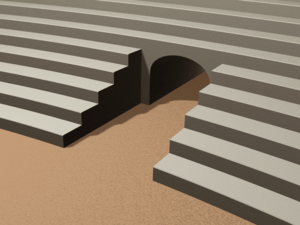Vomitorium facts for kids
A vomitorium is a special passage found in places like ancient Roman amphitheatres, stadiums, or even modern theaters. It's designed to help many people leave quickly after a show or event. Think of it as a wide exit tunnel! These passages can also be used by actors to enter and exit the stage during a play. The word vomitorium comes from the Latin word vomō, which means "to spew forth" or "to pour out," referring to the crowds pouring out of the building.
Contents
What is a Vomitorium?
In ancient Rome, architects were very clever. They built vomitoria to make sure huge crowds could get in and out of big venues like the Colosseum very fast. This helped prevent people from getting stuck or squashed. Today, modern sports stadiums and large theaters still use similar designs for quick exits.
Not What You Think!
Many people mistakenly think a vomitorium was a place where Romans went to throw up after eating too much. This is a common myth! The word sounds similar to "vomit," but a vomitorium was always about moving crowds, not about being sick. It's a passage, not a room for personal use.
Where Can You Find Them Today?
Vomitoria are still used in many modern theaters and stadiums around the world. They are super helpful for both the audience and performers.
Famous Examples Today
- The Smock Alley Theatre in Dublin, Ireland, has two vomitoria that actors use to get on and off the stage.
- The Stratford Festival in Ontario, Canada, also uses these passages for actors.
- At the Oregon Shakespeare Festival, actors call them "voms." They allow performers to come onto the stage from special halls built into the theater.
- The Guthrie Theatre in Minneapolis, Minnesota, has two permanent vomitoria on its main stage.
- The Circle in the Square Theatre in New York City, which is a Broadway theatre, has a vomitorium. It's designed like ancient Greek and Roman theaters and still uses this passage for actors.
- The Cockpit Theatre in London, built in the 1960s, is a unique theater "in the round." It has four vomitoria that act as corner entrances for both the audience and actors.
- The Chichester Festival Theatre in the United Kingdom, opened in 1962, was one of the first modern theaters to use a "thrust stage" design. It has vomitoria for both audience members and performers to enter and exit.
- The Mark Taper Forum in Los Angeles, California, also has two vomitoria because its audience sits around a thrust stage, similar to an amphitheater.
- In Winnipeg, Canada, the Prairie Theatre Exchange has two vomitoria on its thrust stage, with seating on three sides.
- The Space Theatre at the Denver Center for the Performing Arts is shaped like a pentagon. It has five vomitoria spaced evenly around the stage, creating five sections for seating.
See also
 In Spanish: Vomitorio para niños
In Spanish: Vomitorio para niños


